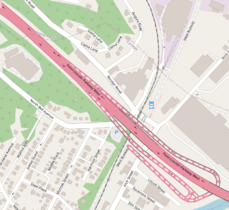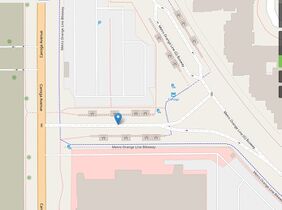Proposal:Tag:highway=busway
| busway | |
|---|---|
| Proposal status: | Approved (active) |
| Proposed by: | colgza |
| Tagging: | highway=busway
|
| Applies to: | |
| Definition: | A dedicated roadway for bus rapid transit systems |
| Statistics: |
|
| Draft started: | 2020-10-16 |
| RFC start: | 2021-03-17 |
| Vote start: | 2021-03-31 |
| Vote end: | 2021-04-14 |
| The Feature Page for the approved proposal * is located at Tag:highway=busway |
Proposal
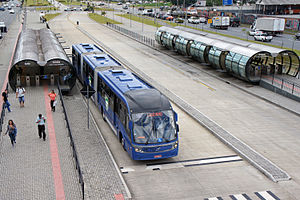
Bus rapid transit (BRT), also called a busway or transitway, is a ![]() bus-based public transport system[1] using dedicated roadways for buses. Busways give priority to buses at intersections where buses may interact with other traffic. These systems have design features which reduce
bus-based public transport system[1] using dedicated roadways for buses. Busways give priority to buses at intersections where buses may interact with other traffic. These systems have design features which reduce ![]() terminal dwell time caused by passengers boarding or leaving buses, or purchasing fares.
terminal dwell time caused by passengers boarding or leaving buses, or purchasing fares.
Proposed are that:
highway=buswayis approved to tag roadways that maintain a high level of importance specifically for bus passengers, but are not meant to be used by motorists, pedestrians, or cyclists- The use of the tagging
highway=service+access=no+bus=designatedfor busways is deprecated. - The tag
service=buswayis deprecated
Sometimes, these roadways are referred to as "fixed guideways" by government agencies,[2] but should not be confused with guided busways, which use rail-like guides or tracks rather than ordinary paved roads. Additionally, this tagging does not apply to painted bus lanes on public roads or transit malls, even though they are also commonly referred to as busways.
Rationale
Why this proposal is necessary
Busways do not meet the definition service roads (or the issue with service=busway)
In addition to making it impossible to differentiate between busways and bus-only service roads, the current tagging schema for busways involves the use of highway=service (as implied by Tag:service=busway). The definition of highway=service is as follows:
Generally for access to a building, service station, beach, campsite, industrial estate, business park, etc. This is also commonly used for access to parking, driveways, and alleys.
Busways do not categorically meet the presented definition of highway=service because of their role as critical transportation infrastructure. The presented definition applies primarily to roadways serving a specific facility, as opposed roadways facilitating travel to many destinations.
Busways are distinct (or why a new highway=* tag is needed)
Some have suggested using other existing values of highway=* (such as motorway or trunk) for busways, whether it be because they have similar physical geometry, or similar functionality (except for the fact that they are bus-only). While their physical similarities are irrelevant as per Proposed_features/Highway_key_voting_importance, there is still debate to be had on whether busways fit within the definition of existing definitions for values of highway=* based on their similar functionality. The crux of the issue is that the road classifications as defined on Key:highway are left deliberately vague, as tagging conventions for public roads vary depending on country.
In other words, tagging busways as if they were public roads would either cause unnecessary variance in the tagging for busways, or require the overriding of local tagging conventions for traffic roads.
Even in the latter case, where local tagging conventions are to be overridden in specific contexts, the dominant tagging scheme would still be ambiguous to which value of highway=* would be correct (assuming values other than service are meant to be used). As it stands, those advocating for this solution have not been able to agree on whether motorway, trunk, or tertiary would be most appropriate, or whether the correct tag should depend on the road.
In any case, reusing existing highway=* values when defining the proper tagging convention for busways would inevitably only increase the level of inconsistency, there by making it more cumbersome to process map data.
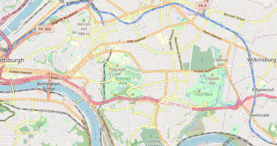
highway=bus_guideway, either due to confusion about the current tagging schema, or due to a user tagging for the renderer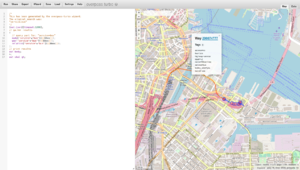
service=bus, instead of the currently accepted service=busway. (290074777 290074777)
290074777)The current tagging schema is confusing (or why the current tagging scheme cannot simply be amended)
Due to the number of tags currently needed to correctly describe busways, they are often tagged incorrectly. Sometimes, they are tagged with highway=unclassified instead of highway=service[3], while other times they are incorrectly tagged with highway=bus_guideway when they are not.
This tagging scheme is often incorrectly used to describe transit malls (also often referred to as busways), where in that highway=service is applied where highway=residential or similar tags may be more appropriate.
The redundant tag service=busway was added to make busways more easily identifiable. However, because this tag is ultimately redundant, and because it is only inconsistently applied (often confused with the unaccepted tag service=bus), it is ultimately unreliable, especially for applications such as rendering.
| Tag | Description | Taginfo |
|---|---|---|
service=busway
|
Used in combination with highway=service + access=no + bus=designated
|
|
service=bus
|
Used to compensate for broken routers that relied on this tag to determine whether service roads are routable for buses. (Invalid, do not use) |
How this proposal was written
Defining busways
The definition of busways as written in #Tagging was carefully written to handle edge cases, as well as avoid relying on access restrictions to define busways.
Lack of a busway_link tag
This proposal initially included a highway=busway_link tag to apply to slip roads/ramps connecting to busways. This was removed after the community at large presumed that any bus-only link road connecting to a busway would only be a part of said busway.
Establishing highway type hierarchy
Busways do not easily fit within the established hierarchy for highway=* tags, as they are more analogous to instances of railway=light_rail, and they exist outside of the road network meant for automobiles (and therefor, outside of the road hierarchy meant for automobiles). In other words, trying to establish the position of busways is like trying to numerically sort a set of complex numbers: different methodologies yield different results, and there is no definitively correct answer.
However, because highway link roads rely on this hierarchy, an arbitrary hierarchical position for busways would need to be established.
Originally, this proposal assumed that any bus-only link road connecting to a busway would be a part of said busway, which would imply highway=busway to be hierarchically above highway=motorway. This proposal was later revised to apply the same assumption to motorways: on-ramps and off-ramps connecting to a motorway are always a part of said motorway. In other words, the arbitrary hierarchical position of highway=busway is above highway=trunk, but below highway=motorway.
- Under the proposed hierarchy, slip roads connecting busways dirrectly to motorways (seen on the left) would continue to be tagged as
motorway_link, but busways connecting dirrectly to other traffic roads would still be tagged withbusway. -
Sliproads connecting the West Busway to the Penn Lincoln Parkway in Pittsburgh, PA. (link)
-
Spur off of the Metro G Busway connnecting to Canoga Avenue in Los Angoles (link)
Examples

The TransMilenio Troncal Americás in Bogotá, Colombia is a 13 kilometer long median-aligned busway that is physically separated from motor traffic, except at intersections.[4] This is an example of a roadway that would be tagged with highway=busway:
-
Elevated busway and bikeway at PA Hospital busway station, Buranda, Queensland
-
MLK Jr East Busway near UPMC Shadyside, Pittsburgh
-
Hidalgo Metrobus station in Mexico City, which has connecting subway service
-
Harmoni Central Busway in Jarkarta, Indonesia
-
Otoyol 1 at PerPa Metrobus station towards northeast to Mecidiyeköy
Tagging
The tag highway=busway should be applied to carriageways that maintain a high level of importance specifically for bus passengers, but are not meant to be used by motorists, pedestrians, or cyclists. In other words, this tag should only apply to roadways used for passenger transport. Currently, such roads are usually tagged with highway=service + access=no + bus=designated.
The tag highway=busway should not be applied to bus-only roadways that are used only for docking.
Use highway=busway also for link roads (sliproads / ramps) leading to and from the main carriageway, as well as for "channelised" (physically separated by an obstruction) at-grade turning lanes connecting the through carriageways/through lanes of the busway to other minor roadways. The table illustrates which highway=* is to be used when mapping link roads connecting to busways. Do not apply highway=busway to any bus-only link roads that does not actually connect to the carriageway of any busway corridors.
| From | To | The link between will be tagged as: |
|---|---|---|
busway
|
service
|
service
|
unclassified/residential
|
busway
| |
tertiary
| ||
secondary
| ||
primary
| ||
trunk
| ||
busway
| ||
motorway
|
motorway_link
|
The tagging highway=* + access=no + bus=yes is used to describe any type of bus-only roadway that does not meet the definition of highway=busway or any similar tags.
Tags used in conjunction
| Tag | Description | Example |
|---|---|---|
| indicates that general traffic is not allowed (implied) | ||
name=*
|
Name of the busway (if applicable) | Martin Luther King Jr. East Busway
|
oneway=yes
|
Indicates whether a section of roadway is one way | |
| Indicates whether other types of large motor vehicles, other than cars, are allowed | ||
embedded_rails=*
|
For when a busway shares a right of way with a (former or current) rail line. | light_rail
|
ref=*
|
Indicates what the reference code for the busway is (if applicable) | |
lanes=*
|
Number of lanes | 2
|
maxspeed=*
|
Maximum speed which is allowed | 60 mph
|
operator=*
|
Name of the operator (if known) | Port Authority of Allegheny County
|
bus_bay=*
|
Whether a section of busway contains a bus bay. | |
surface=*
|
The type of road surface used | concrete
|

Tramways and light railways
Some busways share a right of way with tramways/light railways, often being referred to by the more-general term "transit way." These transit ways mapped as any other type of roadway with embedded tracks would be (as per Trams#Embedded_tracks):
The geometry of the roadway and the tracks should be separated entirely. The roadway should be mapped by a way with highway=busway + embedded_rails=*, while each single track should be mapped as railway=* according to its real position.
Similar infrastructure
The following features may allow access buses while restricting other forms of traffic, but they should not be tagged with highway=busway:
| Feature | Description | Example | Correct Tagging Scheme |
|---|---|---|---|
| Bus-only service roads | These are short service roads connecting to bus-specific facilities (such as bus garages) off of the main carriageway.
|
 |
highway=service + access=no + bus=yes
|
| Bus-only motorway links | These are motorway sliproads/ramps that are designated for buses only.
|
Ramps leading into Port Authority Bus Terminal in New York City, in which general traffic is disallowed. Image. |
Any section of bus-only roadway that connects to any regular traffic road should be tagged with highway=motorway_link + access=no + bus=designated.
|
| Physically-separated bus bypass lanes | These are short stretches of bus-only roadway at intersections that allow buses priority through an intersection before re-entering general traffic. | A designated bus-only throughway off of Piccadilly Circus in London. | To determine the correct value of highway=*, consult the lookup table for link roads between different highways types. Apply bus=yes in addition to any other appropriate access tag.
|
| Also often referred to as a busway, a transit mall is a street, or set of streets, in a city or town along which automobile traffic is prohibited or greatly restricted and only public transit vehicles, bicycles, and pedestrians are permitted.[5]
These types of roads may experience high levels of conflict between pedestrian/bike traffic, and bus traffic. |
 |
highway=unclassified (or a similar tag) and bus=designated are required.
If a road only allows access motor vehicles reaching their destination, use If taxis are permitted, use If a road requires motor vehicles to turn right at the next intersection, use turn restrictions. If the restrictions on motor vehicles only applies during certain hours of the day, use conditional restrictions. | |
| Physically-seperated Bus Bays | Bus bays are areas outside the main carriageways for buses to pick up and drop off passengers. Some bus bays are physically separated from the road. | highway=service + bus_bay=*
| |
| Painted bus lanes | These are bus lanes that are not physically separated from general traffic. |  |
Please consult Key:busway and Bus lanes. |
| HOV Lanes | These are physically separated sections of roads on motorways where motor vehicles must contain a minimum number occupancy in order to be allowed access. Sometimes, buses are routed onto these roads. |  |
Please consult Key:hov. |
Applies to
Features/Pages affected
busway=*highway=*highway=bus_guidewayservice=busway, which would be deprecated.- Link roads between different highways types
External discussions
- Discussion in tagging mailing list
- Issue for openstreetmap-carto to render busways. GitHub
- Discussion on a changeset (achavi, OSMLab, FacilMap)
- Vote on proposal for adding bus guideways to determine which tag value should be used
- Video example of a busway in Boston, MA
Comments
Please comment on the discussion page.
References
- ↑ “What is BRT?”. Institute for Transportation and Development Policy.
- ↑ https://www.transit.dot.gov/funding/grant-programs/capital-investments/about-program
- ↑ History of 336499789
 336499789
336499789
- ↑ https://brtdata.org/location/latin_america/colombia/bogota
- ↑ Transit mall on Wikipedia
Voting
Voting on this proposal has been closed.
The result is Approved with 36 votes for, 5 votes against and 1 abstention.
 I approve this proposal. --Hike&Map (talk) 00:30, 31 March 2021 (UTC)
I approve this proposal. --Hike&Map (talk) 00:30, 31 March 2021 (UTC) I approve this proposal. --Colgza (talk) 00:34, 31 March 2021 (UTC)
I approve this proposal. --Colgza (talk) 00:34, 31 March 2021 (UTC) I approve this proposal. Bus rapid transit roads should not be classified as service roads and deserve a top-level tag. --ZeLonewolf (talk) 00:37, 31 March 2021 (UTC)
I approve this proposal. Bus rapid transit roads should not be classified as service roads and deserve a top-level tag. --ZeLonewolf (talk) 00:37, 31 March 2021 (UTC) I approve this proposal. --Mxdanger (talk) 00:46, 31 March 2021 (UTC)
I approve this proposal. --Mxdanger (talk) 00:46, 31 March 2021 (UTC) I approve this proposal. Bus roads are not service roads. --BubbaJuice (talk) 01:22, 31 March 2021 (UTC)
I approve this proposal. Bus roads are not service roads. --BubbaJuice (talk) 01:22, 31 March 2021 (UTC) I approve this proposal. --JayTurnr (talk) 01:46, 31 March 2021 (UTC)
I approve this proposal. --JayTurnr (talk) 01:46, 31 March 2021 (UTC) I approve this proposal. --clay_c (talk) 02:41, 31 March 2021 (UTC)
I approve this proposal. --clay_c (talk) 02:41, 31 March 2021 (UTC) I approve this proposal. BRTs are special in multiple ways and need dedicated tagging Arlo James Barnes (talk) 03:09, 31 March 2021 (UTC)
I approve this proposal. BRTs are special in multiple ways and need dedicated tagging Arlo James Barnes (talk) 03:09, 31 March 2021 (UTC) I approve this proposal. thanks for the very in-depth proposal and the constructive discussions leading up to it --Hedaja (talk) 13:03, 31 March 2021 (UTC)
I approve this proposal. thanks for the very in-depth proposal and the constructive discussions leading up to it --Hedaja (talk) 13:03, 31 March 2021 (UTC) I approve this proposal. --Adamfranco (talk) 13:08, 31 March 2021 (UTC)
I approve this proposal. --Adamfranco (talk) 13:08, 31 March 2021 (UTC)
 I approve this proposal. --Alex Mapper (talk) 13:36, 31 March 2021 (UTC)
I approve this proposal. --Alex Mapper (talk) 13:36, 31 March 2021 (UTC) I approve this proposal. --Dimitar155 (talk) 13:40, 31 March 2021 (UTC)
I approve this proposal. --Dimitar155 (talk) 13:40, 31 March 2021 (UTC) I approve this proposal. (Comment added later) Wiki may need a disambiguation page for busways, because as i understand,
I approve this proposal. (Comment added later) Wiki may need a disambiguation page for busways, because as i understand, busway=*is used for bus lanes, whilehighway=buswayis used for dedicated roads utilized by special kind of public transport. --Fghj753 (talk) 15:04, 31 March 2021 (UTC) I oppose this proposal. I disagree with the need to map all "busways" in this manner. The scope is too broad and regular classification of the highway type and adding access tags is sufficient for most busways in Europe and certainly Sweden. I will support this tag for true BRT roads, but not regular roads that happen to have signs for bus-only and that connect to the regular road network. --Riiga (talk) 16:12, 31 March 2021 (UTC)
I oppose this proposal. I disagree with the need to map all "busways" in this manner. The scope is too broad and regular classification of the highway type and adding access tags is sufficient for most busways in Europe and certainly Sweden. I will support this tag for true BRT roads, but not regular roads that happen to have signs for bus-only and that connect to the regular road network. --Riiga (talk) 16:12, 31 March 2021 (UTC)
- Thank you for updating your reasoning for voting no to be more detailed. I deliberately avoided relying on any specific definition of the term "bus rapid transit," as it is a notoriously vague term, often subject to having its definition changing on a whim depending on political needs, so I do not know how to differentiate between "true BRT roads" and "regular roads that happen to have signs for bus-only and that connect to the regular road network." In a conversation about this elsewhere, you shared 345276580
 345276580 as an example of a "bus-only tertiary road," but I would consider this a perfect example of
345276580 as an example of a "bus-only tertiary road," but I would consider this a perfect example of highway=busway. I don't really see how I could possibly write a definition of busway to include the East Busway in Pittsburgh, while excluding that. —Colgza (talk) 18:17, 31 March 2021 (UTC)
the East Busway in Pittsburgh, while excluding that. —Colgza (talk) 18:17, 31 March 2021 (UTC)
- From looking at your example it seems the East Busway in Pittsburgh is such a coherent system of dedicated bus transit that it qualifies as BRT and would be covered by this proposal even if the scope was narrowed. Here's the current tagged bus infrastructure in my city. Ways like this are just extensions of, or converted parts of, a regular residential road. They fit into the road network and sometimes they are even turned back into a regular street when bus lines are replanned (see object history). The only change in this case was to remove the bus-only signs which is the same as changing the access tags. The road didn't magically turn from a
highway=buswayback into ahighway=residentialbecause those signs were removed. There is a difference between dedicated busways for BRT and bus-only roads that exist as part of the regular road network and this is why I can't support this proposal in its current form. --Riiga (talk) 20:53, 31 March 2021 (UTC)
- From looking at your example it seems the East Busway in Pittsburgh is such a coherent system of dedicated bus transit that it qualifies as BRT and would be covered by this proposal even if the scope was narrowed. Here's the current tagged bus infrastructure in my city. Ways like this are just extensions of, or converted parts of, a regular residential road. They fit into the road network and sometimes they are even turned back into a regular street when bus lines are replanned (see object history). The only change in this case was to remove the bus-only signs which is the same as changing the access tags. The road didn't magically turn from a
- Thank you for updating your reasoning for voting no to be more detailed. I deliberately avoided relying on any specific definition of the term "bus rapid transit," as it is a notoriously vague term, often subject to having its definition changing on a whim depending on political needs, so I do not know how to differentiate between "true BRT roads" and "regular roads that happen to have signs for bus-only and that connect to the regular road network." In a conversation about this elsewhere, you shared 345276580
 I approve this proposal. Pnorman (talk) 16:14, 31 March 2021 (UTC)
I approve this proposal. Pnorman (talk) 16:14, 31 March 2021 (UTC) I approve this proposal. Busways aren't service ways — simple as that for me. --Rayleigh1 (talk) 16:16, 31 March 2021 (UTC)
I approve this proposal. Busways aren't service ways — simple as that for me. --Rayleigh1 (talk) 16:16, 31 March 2021 (UTC) I approve this proposal. --GOwin (talk) 09:02, 2 April 2021 (UTC)
I approve this proposal. --GOwin (talk) 09:02, 2 April 2021 (UTC) I approve this proposal. --Lectrician1 (talk) 21:35, 2 April 2021 (UTC)
I approve this proposal. --Lectrician1 (talk) 21:35, 2 April 2021 (UTC) I approve this proposal. --Guillemmal (talk) 22:40, 2 April 2021 (UTC)
I approve this proposal. --Guillemmal (talk) 22:40, 2 April 2021 (UTC) I approve this proposal. Well-written proposal, and long overdue. Service ways have never quite made sense for busways --Dericke (talk) 17:44, 3 April 2021 (UTC)
I approve this proposal. Well-written proposal, and long overdue. Service ways have never quite made sense for busways --Dericke (talk) 17:44, 3 April 2021 (UTC) I approve this proposal. -- Sammyhawkrad (talk)15:33, 4 April 2021 (UTC)
I approve this proposal. -- Sammyhawkrad (talk)15:33, 4 April 2021 (UTC) I approve this proposal. Busways are meant to be uniquely distinguished from the regular service roadways, like the one here in Metro Manila. --DP24 04:01, 5 April 2021 (UTC)
I approve this proposal. Busways are meant to be uniquely distinguished from the regular service roadways, like the one here in Metro Manila. --DP24 04:01, 5 April 2021 (UTC) I approve this proposal. Good work. This will be useful. --Fizzie41 (talk) 04:56, 5 April 2021 (UTC)
I approve this proposal. Good work. This will be useful. --Fizzie41 (talk) 04:56, 5 April 2021 (UTC) I approve this proposal. I'm not 100% sure this is necessary, but I see no disadventage to use this well-defined scheme. Thank you for your work ! --Gileri (talk) 21:16, 5 April 2021 (UTC)
I approve this proposal. I'm not 100% sure this is necessary, but I see no disadventage to use this well-defined scheme. Thank you for your work ! --Gileri (talk) 21:16, 5 April 2021 (UTC) I approve this proposal. --LeifRasmussen (talk) 16:40, 6 April 2021 (UTC)
I approve this proposal. --LeifRasmussen (talk) 16:40, 6 April 2021 (UTC) I approve this proposal. Seems good to me. Busways don't fit in with the other types of roads
I approve this proposal. Seems good to me. Busways don't fit in with the other types of roads highway=serviceis used for (driveways, parking aisles, emergency access, allys, etc). -- Ezekielf (talk)
 I approve this proposal. --YoViajo (talk) 22:22, 7 April 2021 (UTC)
I approve this proposal. --YoViajo (talk) 22:22, 7 April 2021 (UTC) I approve this proposal. Hopefully the renders do not delay in implementing it. I would add a busway_link. --AgusQui (talk) 03:04, 9 April 2021 (UTC)
I approve this proposal. Hopefully the renders do not delay in implementing it. I would add a busway_link. --AgusQui (talk) 03:04, 9 April 2021 (UTC) I approve this proposal. This will save people a lot of fiddling with access tags. Good job. --501ghost (talk) 12:59, 9 April 2021 (UTC)
I approve this proposal. This will save people a lot of fiddling with access tags. Good job. --501ghost (talk) 12:59, 9 April 2021 (UTC) I approve this proposal. --Eginhard (talk) 15:25, 9 April 2021 (UTC)
I approve this proposal. --Eginhard (talk) 15:25, 9 April 2021 (UTC) I oppose this proposal. BRT's do not deserve a new top level highway tag, making this already classification mix even more messy. Worldwide these BRT's are mapped as highway=service roads without confusion or much ambiguity. A new
I oppose this proposal. BRT's do not deserve a new top level highway tag, making this already classification mix even more messy. Worldwide these BRT's are mapped as highway=service roads without confusion or much ambiguity. A new service=*value would be more appropriate and better support for extension of existing mapping and tagging. This proposal will create a duplicate tagging scheme for the same feature. --Bert Araali (talk) 15:34, 10 April 2021 (UTC)
- I fail to see why
service=buswayis "more appropriate." This tag does not imply any other tags; it is meant to be used 'in conjunction with'access=no+bus=designated/private. Even now withservice=buswayas a part of the status quo, it is exceedingly difficult to form an Overpass Turbo query for busways without it yielding both false positives and false negatives. This proposal will create a duplicate tagging scheme for the same feature.
- On the contrary, by deprecating a tagging scheme that is applied incorrectly and inconstantly and replacing it with a simpler one, this proposal would decrease the level of variance in the tagging. —Colgza (talk) 17:46, 11 April 2021 (UTC)
- I fail to see why
 I have comments but abstain from voting on this proposal. Although I like the proposal as busways are the 'odd one' in the service ways, I do not understand why a busway leading from a motorway would be different from a busway leading from any other way. It's dedicated to buses only from the second you exit the motorway (or trunk or ...), right? --Famlam (talk) 10:56, 11 April 2021 (UTC)
I have comments but abstain from voting on this proposal. Although I like the proposal as busways are the 'odd one' in the service ways, I do not understand why a busway leading from a motorway would be different from a busway leading from any other way. It's dedicated to buses only from the second you exit the motorway (or trunk or ...), right? --Famlam (talk) 10:56, 11 April 2021 (UTC) I approve this proposal. --EneaSuper (talk) 11:45, 11 April 2021 (UTC)
I approve this proposal. --EneaSuper (talk) 11:45, 11 April 2021 (UTC) I approve this proposal. --Jonaes (talk) 13:07, 11 April 2021 (UTC)
I approve this proposal. --Jonaes (talk) 13:07, 11 April 2021 (UTC) I oppose this proposal. This proposal is based on the flawed premise that "highway=busway" is somehow a distinct class of road. It's not - there are shades of grey. Just a few miles where I am there are what you might consider "busways" that are for "scheduled buses only, but not others" and "scheduled buses only, but not others, unless they're going to a theatre". This tag is a bad idea for the same reason that highway=ford on a way is a bad idea - it prevents us from tagging the class of road that the ford (or in this case busway) is. --SomeoneElse (talk) 14:04, 11 April 2021 (UTC)
I oppose this proposal. This proposal is based on the flawed premise that "highway=busway" is somehow a distinct class of road. It's not - there are shades of grey. Just a few miles where I am there are what you might consider "busways" that are for "scheduled buses only, but not others" and "scheduled buses only, but not others, unless they're going to a theatre". This tag is a bad idea for the same reason that highway=ford on a way is a bad idea - it prevents us from tagging the class of road that the ford (or in this case busway) is. --SomeoneElse (talk) 14:04, 11 April 2021 (UTC) I approve this proposal. --Tokada (talk) 14:19, 11 April 2021 (UTC)
I approve this proposal. --Tokada (talk) 14:19, 11 April 2021 (UTC) I approve this proposal. This is an excellent, well-thought-out proposal, and very much-needed. --ForgottenHero (talk) 15:13, 11 April 2021 (UTC)
I approve this proposal. This is an excellent, well-thought-out proposal, and very much-needed. --ForgottenHero (talk) 15:13, 11 April 2021 (UTC) I oppose this proposal. Agree with Bert Araali and SomeoneElse --Recoil16 (talk) 16:20, 11 April 2021 (UTC)
I oppose this proposal. Agree with Bert Araali and SomeoneElse --Recoil16 (talk) 16:20, 11 April 2021 (UTC) I approve this proposal. --Gendy54 (talk) 17:38, 11 April 2021 (UTC)
I approve this proposal. --Gendy54 (talk) 17:38, 11 April 2021 (UTC) I approve this proposal. --Abdullah abdulrhman (talk) 18:57, 11 April 2021 (UTC)
I approve this proposal. --Abdullah abdulrhman (talk) 18:57, 11 April 2021 (UTC) I approve this proposal. --Reino Baptista (talk) 06:18, 13 April 2021 (UTC)
I approve this proposal. --Reino Baptista (talk) 06:18, 13 April 2021 (UTC) I oppose this proposal. I agree that highway=service is incorrect to describe those ways dedicated to bus transit traffic. I am against the idea of having one highway "transit" value for cars, another for buses, another for trucks, one for electric buses, another for high occupancy cars as all these different tags are just access tags on the same road infrastructure. therefore it would be better to use the existing tags, e.g. highway=primary or secondary or tertiary access=no bus=yes Marc marc (talk) 22:15, 14 April 2021 (UTC)
I oppose this proposal. I agree that highway=service is incorrect to describe those ways dedicated to bus transit traffic. I am against the idea of having one highway "transit" value for cars, another for buses, another for trucks, one for electric buses, another for high occupancy cars as all these different tags are just access tags on the same road infrastructure. therefore it would be better to use the existing tags, e.g. highway=primary or secondary or tertiary access=no bus=yes Marc marc (talk) 22:15, 14 April 2021 (UTC)
